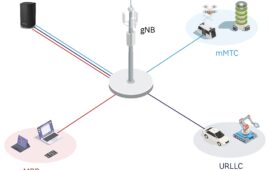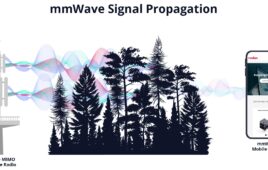If you’ve been following 5G technical developments for the last few years, you probably know that 5G encompasses more than just faster download speeds. You may have heard about low latency (1 msec or less) and the applications that makes possible. Now, 5G is in deployment and the hype far exceeds reality. The hype, of course, is beamed at consumers and their mobile phones.
What’s the real situation and what’s driving it all? It’s traffic, of course. To find out why and how, 5G Technology World spoke with telecom industry analyst and consultant Clifford Holliday, who recently authored 5G: What Are the Real Status and the Real Economics? published by IGI Group. 5G Technology World recently published a summary of the report, but we wanted more. 5GTW editor Martin Rowe spoke with Holliday on January 15. Here’s what he had to say.

Clifford Holliday
Holliday: Let’s start by asking “What drives 5G and why do we want it?” After all, it’s the next shiny engineering toy and the next number up the wireless ladder. While engineers have been developing 5G for years, now there is a real need: traffic. It’s growing so fast that the existing infrastructure can no longer keep up. We’re seeing that in large cities now. Cell towers have more and more antennas in high-traffic areas, which is a symptom of the problem. 4G doesn’t have the bandwidth to keep up with traffic projections.
Cisco says that mobile traffic per phone will grow at a compound rate of 36 percent per year for the foreseeable future. That means traffic will double in just over two years and will double again in another two years. That’s an astounding problem to confront when you’re already at the limits 4G LTE.
Holliday: We need something to replace LTE or live with the congestion. Incidentally, the traffic is largely video. It’s something like 70 to 80 p

LTE is no longer
“long term.”
ercent of all mobile traffic. That’s the real rationale for 5G. People have talked about 5G being supported by IoT and autonomous vehicles and 5G is perfect for autonomous vehicles. Unfortunately, that kind of 5G (high speed, low latency) is very expensive and won’t be around for a while. Plus, the vehicles that need such a feature in 5G won’t be around for a while and maybe not at all. Auto makers are getting close to developing autonomous vehicles anyway.
IoT is the opposite. It’s already in full bloom and has networks that are already carrying it. When 5G is fully built out, it may not even participate in IoT because it may be too expensive to use in low-cost devices. IoT needs cheap, low-end devices.
IoT and autonomous vehicles will never be the justification for 5G. What’s left is traffic.
AT&T and Verizon are addressing it in fundamentally different ways than are Sprint and T-Mobile. AT&T and Version are spotting in mmWave small cells. AT&T, for example, is placing the small cells in places such as Texas Stadium here in Dallas. Verizon and AT&T are also installing in downtown areas of cities. At the present time, each is in about thirty cities. Right now, the small cells serve very small sections such parts of city blocks or maybe a whole block.
Remember that the purpose of 5G is to alleviate the traffic problem and move it off LTE. To do that, you need subscribers on the 5G networks. If 5G is only in a few places and few handsets have 5G capability, very little traffic is carried aver 5G. Secondly, you need a 5G phone that works with that subscriber’s network. But, networks use different 5G implementations. While AT&T has some mmWave implementations, it may also use much lower frequency bands. The same phone won’t work on both; the same AT&T phone won’t work on both. That’s an issue. We need to engineer devices that will work across all the bands. If, in fact, the carriers employ all the available bands at it looks like they will. Qualcomm, Apple, Intel, and Samsung are all working on chipsets and I assume those chipsets will handle all cellular frequency bands. Remember, the goal is to move traffic to 5G.
While we’ve always had spectrum fragmenting across carriers, 5G is causing fragmenting of frequency bands, even with a carrier. Engineers need to develop these “cross-breed” devices.
Holliday: I have seen a hospital application that AT&T is setting up. A 5G network in the hospital gives doctors immediate access to scans and other information. It uses mmWave to send data around the campus.
Holliday: Low latency is one of the benefits of 5G, particularly for autonomous vehicles where you need fast response. The same applies to robots. Whether or not industrial applications are enough to drive building 5G networks is another deal. 5G networks are very expensive, especially at mmWave frequencies. The hospital network is just for a local area. For applications that would use the existing 5G network, those don’t exist yet. IIoT won’t exist without a rationale for it.
In the case of IoT, there are a number of networks technologies that handle it today. In those applications, it will be difficult to show that 5G will do better.

Holliday: It’s got to come from the consumers first. My report projects 50 billion IoT devices in the next few years. Now you’re talking enough data to justify 5G. It’s the number of points and the consumer demand. That’s where engineers need to come in and develop enough inexpensive IoT devices. I still think the rationale for building 5G comes from traffic. To reach that point, we need the network and access to it. That comes back to handsets that will work on lots of different networks. People won’t want different phones for different frequency bands.
Holliday: The mmWave network is really a fiber network even more than a radio network. All those small cells need fiber. Building the wireless network and coordinating it with other uses of fiber is a huge undertaking. Verizon has launched One Fiber, an effort to make use of fiber in a more efficient and economical way. Extending fiber’s reach to cover small cells is a tremendous engineering problem. The idea is to use fiber for not only small cells, but in combination of getting fiber to homes and businesses. You deploy once and get three uses from the same fiber. We tried something similar when I worked at GTE, but it failed. Coordinating the deployment of all that fiber for 5G is a huge problem. Remember that 5G mmWave has a short distance because of the high frequencies. I suspect that the expense of deploying the fiber is greater than that for the electronics.
Holliday: Sprint is using the mid-band 2.5 GHz while T-Mobile is using 600 MHz. (Ed. Note: AT&T is using 700 MHz in addition to mmWave). You get much better range that at higher frequencies, but not everything else that comes with 5G. It’s in the spec, but it’s just barely 5G. So, while T-Mobile is selling 5G, the company is really providing just a little more than 4G but with better signal range.
Related: Report: 5G can’t fall back to LTE





I just ran across this. I had forgotten this interview. A quick perusal suggests that it is still just about right today (4-3-22).
I hope to soon do a new report on 5G for Information Gatkeepers. Keep an eye on their web site for availability.
CLIF Holliday